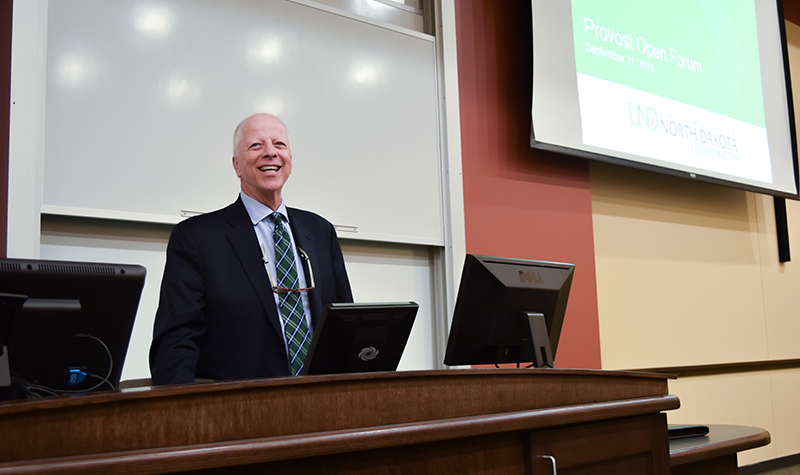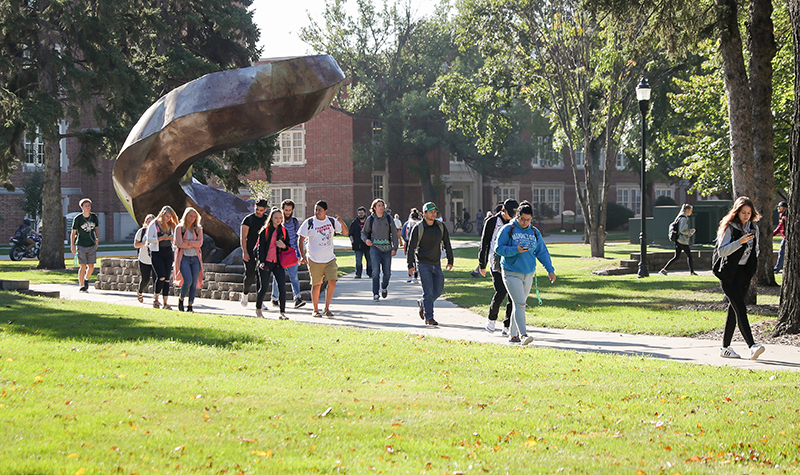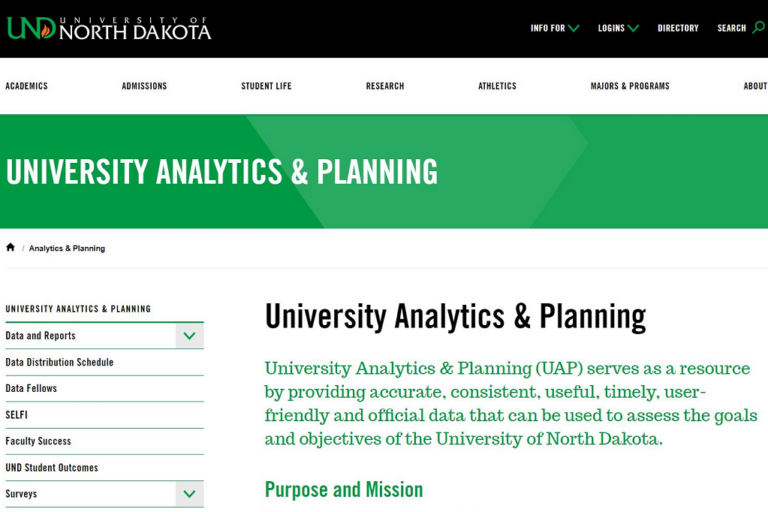The ‘Year of Retention’ at UND
After gaining ground with graduation rates, emphasis shifts to another Strategic Plan goal: student retention

First it was graduation rates, a core element of the One UND Strategic Plan.
Now…
“I’ve dubbed this year as the Year of Retention,” said Tom DiLorenzo, UND provost and vice president of academic affairs, at the Provost’s Forum on campus in September.
“We’ve done a fabulous job with enhancing graduation rates. Over the past three years, we’ve boosted our graduation rates by more than 10 percent.
“That’s phenomenal,” he added. “No other university that I know of can make that statement. It’s tremendous.”
“But we haven’t done quite as well on retention,” even though boosting retention rates also is a part of the strategic plan, DiLorenzo said.
Indeed, the University’s most recent figures back this up: Retention fell slightly this year, as the fourth-week enrollment figures show. That means the freshmen who entered UND last fall were a little less likely to return as sophomores than were the freshmen who entered two years ago, in 2017.
“We need to be working on ways of keeping students here from fall to spring and beyond,” DiLorenzo said at the Provost’s Forum.
“So, I am working with the deans, the core and professional advisors and other individuals from across campus to help us with retention. And you can all participate in that,” DiLorenzo added, sweeping his arm to indicate the audience.
Students are customers, and we can learn a lot from how successful retailers treat their customers, he suggested. Student service and retention go hand in hand.
“At any given point in time, you can just say to a student, ‘How are you doing?’” the provost said at the forum.
“You can just reach out and say, ‘How can I help you?’ And those are important things, because if students feel like they are part of a community – if they feel like they are being recognized – if they feel like someone cares about them, that plays a huge part in their decision to stay at UND.”
Recently, DiLorenzo spoke in more detail with UND Today about the University’s Year of Retention plans.
As mentioned, it’s all about student service and caring for each other, he said. But it’s especially about data-driven student service, meaning those practices that have proven effective at UND and elsewhere at boosting retention.

Starfish
Starfish is one such tool. Already familiar to most on campus, Starfish is an online student success platform whose use at UND gets more robust every year. Using Starfish, faculty can tell students when they are falling short, when they are doing well and how they can continue to be Leaders in Action.
As important, Starfish gives faculty an “early alert” system to quickly communicate to students, advisors and others when students are having attendance or other difficulties.
“By being able to say things like, ‘Hey, I see that you weren’t in class for a few days. Is anything going on?’, you can step in and maybe coach or help them before they are thinking about dropping out,” DiLorenzo said.
Starfish is a formal part of the One UND Strategic Plan and one of many action items in Goal 2, which has set UND on a path to increasing retention as well as graduation rates.
HIPs
If you’re a recent UND graduate, some of your most memorable academic or career-building experiences may not have taken place in a classroom. Maybe you conducted research with a faculty member; maybe you had an internship at a startup, where you brainstormed new strategies in the same room as the entrepreneurs.
If that fits your experience, it’s no accident. UND has come to understand and embrace the importance of HIPs, or High Impact Practices. HIPs are educational experiences with a strong active-learning component. First-year seminars are an early example. So are learning communities, writing-intensive courses, e-portfolios and capstone courses or projects.
At UND, the data show that most students have had at least three high-impact practices by the time they graduate. And because HIPs are so strongly associated with retention, the University is trying to make sure students have even more opportunities to experience them during their college careers, DiLorenzo said.

Transfer students
Once upon a time, transferring to a university such as UND was a shot in the dark. Maybe the transfer student’s new university would accept his or her credits; maybe the university wouldn’t. Moreover, maybe it would take weeks for that university to make its decision – or maybe it would take months.
That’s not exactly a retention-friendly environment, DiLorenzo said, which is why at UND, transfer students now learn the status of their credits within one to three days.
“This takes an exceptional effort, but it’s worth it,” DiLorenzo said.
First, the Registrar’s Office fast-tracks the student’s transcript. Second, core and professional advisers work one-on-one with student files, quickly putting them in front of the right faculty evaluators – who, in turn, also work with care and rigor, but at a stepped-up pace. Finally, advisers contact students with their equivalencies and a plan for registration.
The net result is student service that can save students months of uncertainty, DiLorenzo said.
“This was one example where we used data to inform us,” he said.
“We saw how long it was taking, and we knew it just wasn’t good. So we created a plan, we executed it – and now the students are benefiting tremendously.”
The growth in the number of transfer students matriculating at UND is directly correlated with this effort, DiLorenzo said.
Degree planner
We’ve come a long way from the days of students standing in lines in front of the Registrar’s Office, with their crossed-out and scribbled-on course schedules – each on a flimsy piece of computer paper — in hand.
These days, the digital scheduler “allows students to enter the classes they need in a given semester, and the tool will create a number of schedule possibilities that can be filtered according to work schedules, student organization/team commitments, or even sleep preferences (for those late risers),” as UND Today has reported.
The software also can “extend that planning capability to the full span of the degree. If a course can’t be completed in the initially planned semester, or program requirements change, the degree plan will offer solutions to keep the student on track.”
The common thread in all of the above efforts is clear: Take away obstacles that hinder student success.
Said DiLorenzo, “I’ve said this before, but it’s worth repeating: We’re not trying to make things easier academically. We’re trying to make them easier bureaucratically.”
The Year of Retention will have UND redoubling its efforts to put best-practice solutions in place, he said. Everyone from across campus, regardless of their position, is asked to participate for the benefit of the student and UND.
“We’re finding strategies that have been proven to work. We’re putting these programs in place all across campus. And we’re seeing great results.”



